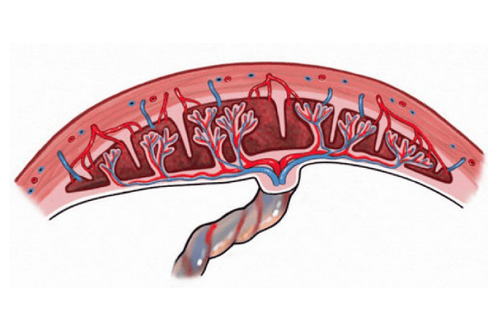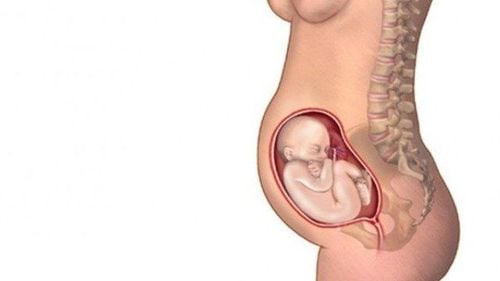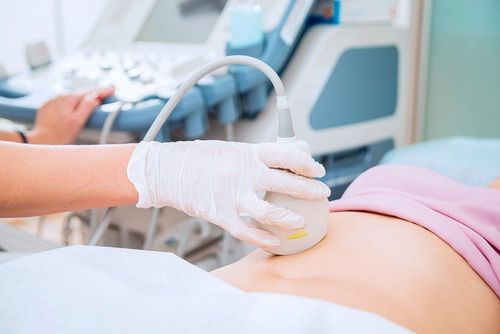This is an automatically translated article.
The article is professionally consulted by Master, Doctor Ly Thi Thanh Nha - Department of Obstetrics and Gynecology - Vinmec International General Hospital Da Nang. Doctor Nha has strengths and experience in fetal malformation ultrasound, 3D, 4D fetal ultrasound.The placenta is an important part that contributes to the nourishment of the fetus, helping the blood and nutrients from the mother to be passed to the fetus. However, for each person, the position of the placenta is different and there are special positions that pregnant women need to pay attention to.
1. Where is the placenta located?
Normally, the placenta is located at the following points:The placenta is behind the uterus The placenta is in front of the uterus The placenta is on the side of the uterus The placenta is attached to the bottom of the uterus The placenta lying low at the bottom of the uterus or just above the cervix The location of the placenta can be different for each pregnant woman. When you have a pregnancy ultrasound, your doctor will help you know if the placenta is in a safe position or if there is a problem.
2. Some special placenta positions
There are some cases where the placenta is located in a special position that can be dangerous for a pregnancy. So where is the placenta, it should be noted?2.1 Placental placenta low position: The placenta is located below the uterus.
Cause: Because the mother has a malformed uterus or has had an abortion.
Risks:
Low placental position obstructs the path of the fetus during labor. Causes blood loss in pregnant women, and can even cause death. Increased risk of miscarriage or premature birth. These schools require cesarean section or early hospitalization for follow-up.

Cause: Currently, medical science has not yet determined the exact cause of placenta previa. However, there are some risk factors for this condition such as having a history of placenta previa; scarred uterus, especially cesarean sections; people with multiple pregnancies, multiple births; people who have had an abortion; pregnant women smoke...
Risk:
Causes internal bleeding in the third trimester of pregnancy, labor and postpartum. Causing difficult delivery, the ability to adjust the position of the fetus is not good, thereby affecting the health of both mother and baby. Causes vaginal bleeding, blood loss shock, blood clotting disorders in the mother. Possible fetal distress due to anemia, premature birth. The mortality rate of children in placenta previa is relatively high, up to 30-40%. 2.3 Placement of the placenta with comb teeth Location: The placenta is deeply embedded in the uterus and cannot be peeled off after birth.
Cause: The cause of placenta accreta is unknown, but it may be related to placenta previa or due to previous cesarean section. The condition usually occurs in 5-10% of women with placenta previa. In addition, women who have had a cesarean section in the first time have a 4.5 times increased risk of placenta accreta in the next pregnancy compared with those who give birth vaginally.
Risk:
The percentage of people with placenta accreta is 1/2500, this condition can be life-threatening for both mother and fetus. Increased risk of preterm birth, premature labor, and risk of complications. Bleeding is often when the placenta separates, which can be life-threatening for the pregnant woman. The uterus and some other organs of the mother can be damaged during the placental detachment.

3. Ultrasound of the placenta
The position of the placenta can change during pregnancy. Therefore, pregnant women need periodic ultrasound of the placenta to know the status of the placenta.Ultrasound is usually done between 18-20 weeks of pregnancy. In some cases, a placental ultrasound is checked closer to the due date to make sure that the placenta is not blocking the cervix.
Your doctor will check more carefully if you have certain risk factors such as:
Have had uterine surgery, abortion or cesarean section. Women over 30 years old. Pregnant with twins or multiples. Smoker. The fertilized egg is implanted in the lower part of the mother's uterus. Ultrasound is a way to monitor the health of the mother and baby as well as the position of the placenta. If there are any problems, pregnant women need to strictly follow the doctor's instructions to avoid possible serious consequences. In the last 3 months of pregnancy, the health of both mother and baby needs to be closely monitored and checked. Pregnant women need:
Know the real signs of labor to get to the hospital in time, affecting the health of the fetus. Differentiate between amniotic fluid and vaginal discharge for timely treatment to avoid premature birth, fetal distress, and stillbirth. Be especially careful when bleeding in the last 3 months of pregnancy needs urgent emergency care to ensure the life of both mother and baby. Monitor the amount of amniotic fluid regularly and continuously. Monitor fetal weight in the last 3 months to assess baby's development and predict possible risks at birth. The special monitoring group is the same as the striker, and the fetal growth retardation needs to be closely monitored by the doctor and given appropriate indications. Distinguish between physiological contractions, labor contractions and mechanical pregnancy to get to the hospital in time. Maternity service package at Vinmec helps pregnant women's pregnancy become lighter and safer. During pregnancy, pregnant women will be examined by top doctors in the Obstetrics and Gynecology Department with high professional qualifications and experience, giving the best advice and treatment for the health of both mother and child. little.
For detailed information about all-inclusive maternity service packages, please contact the hospitals and clinics of Vinmec Health system nationwide.
Please dial HOTLINE for more information or register for an appointment HERE. Download MyVinmec app to make appointments faster and to manage your bookings easily.














